Introduction to Regional Studies America Latin America Latin
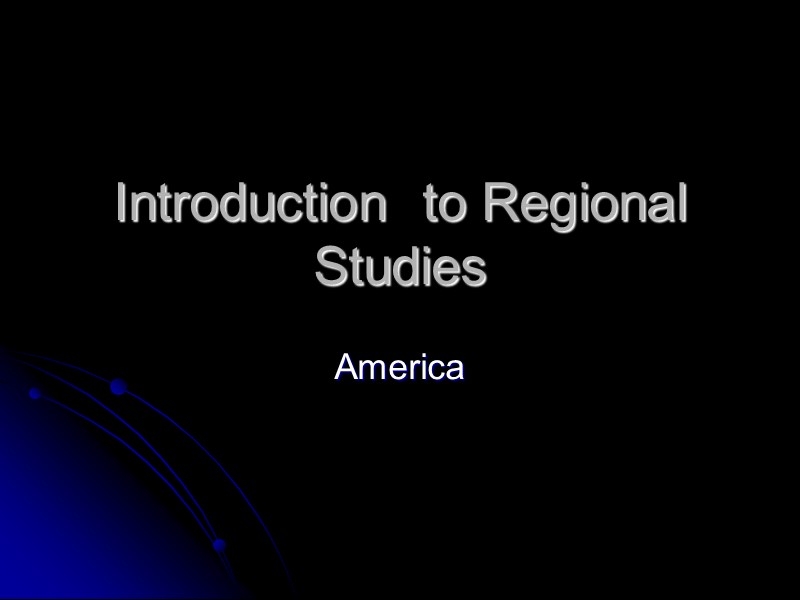
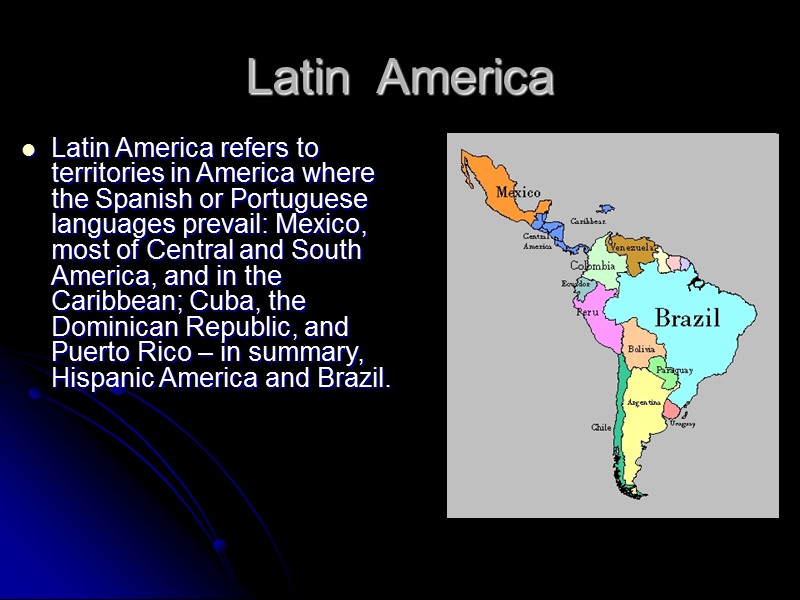
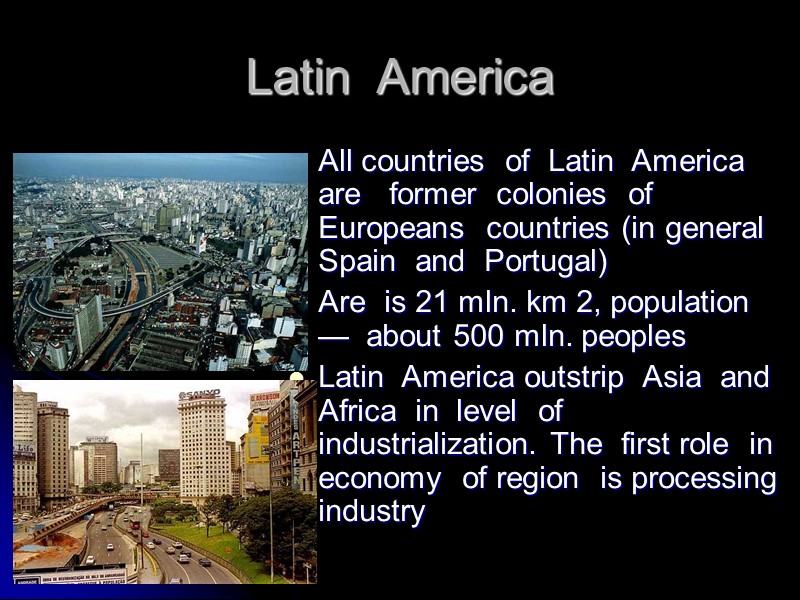
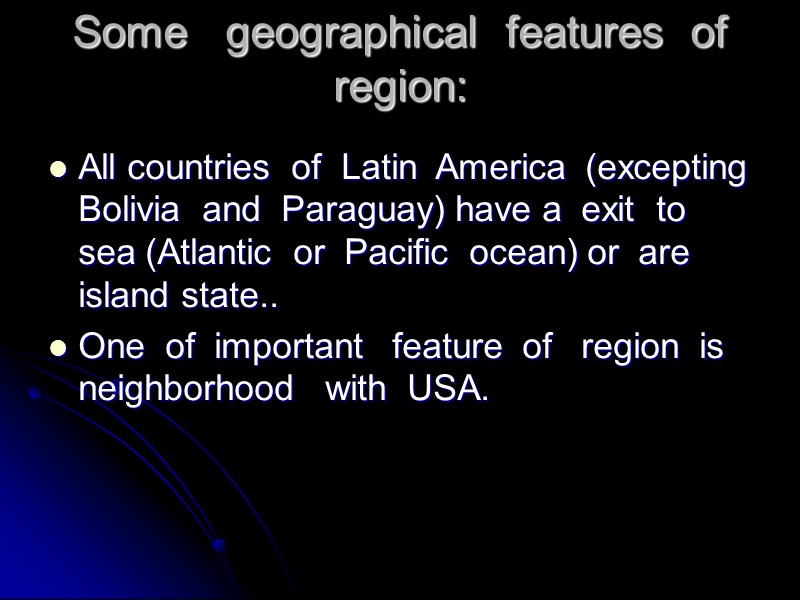
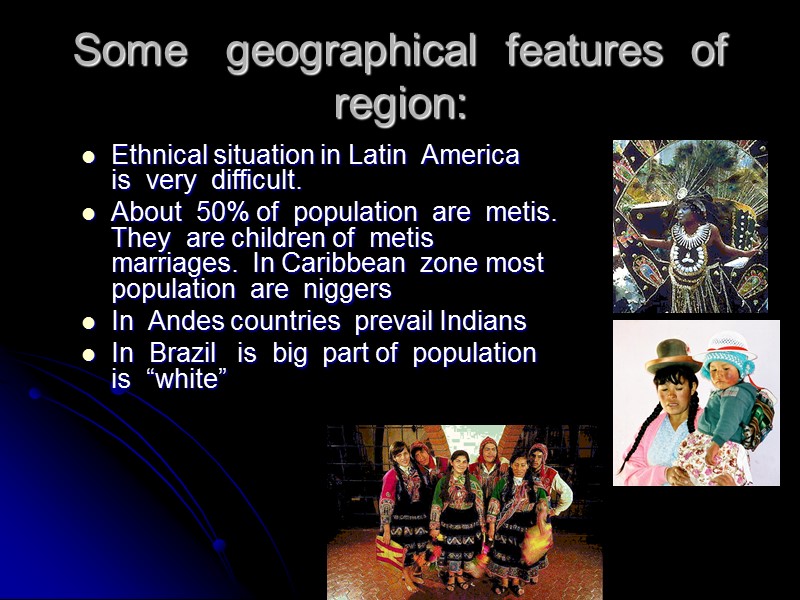
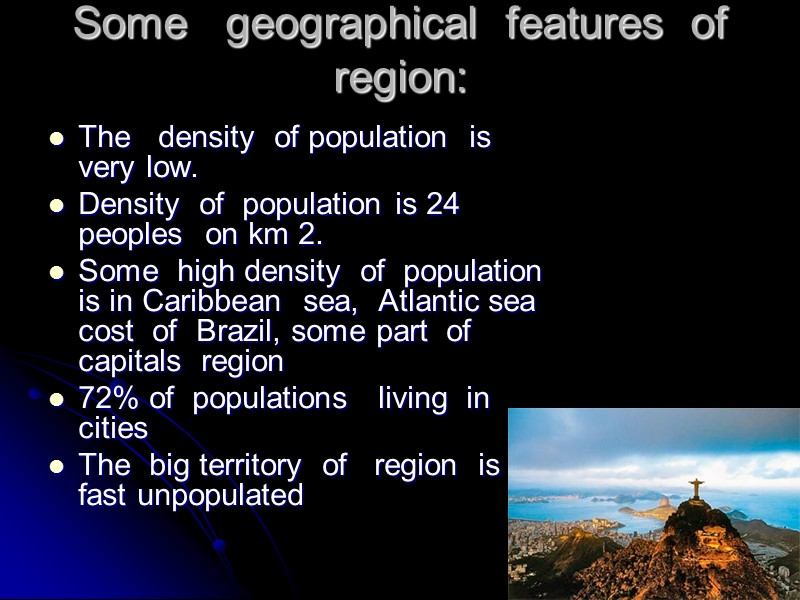
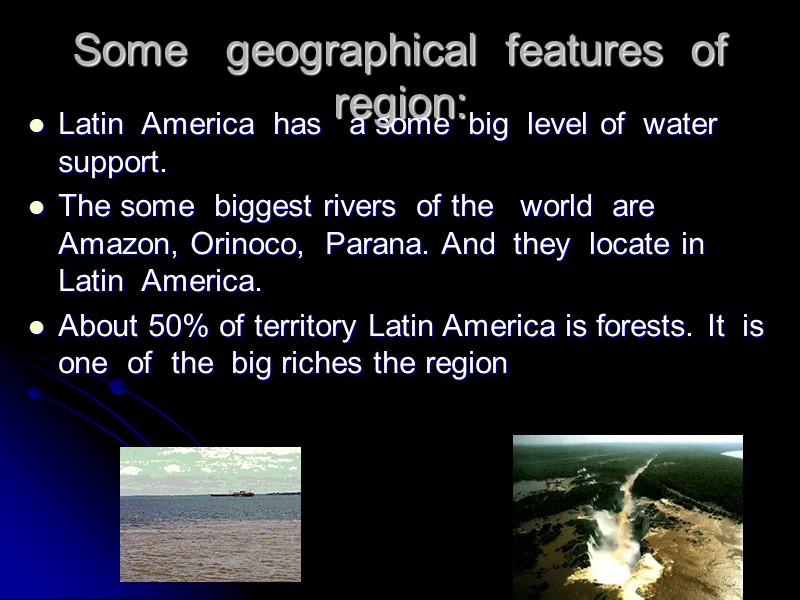
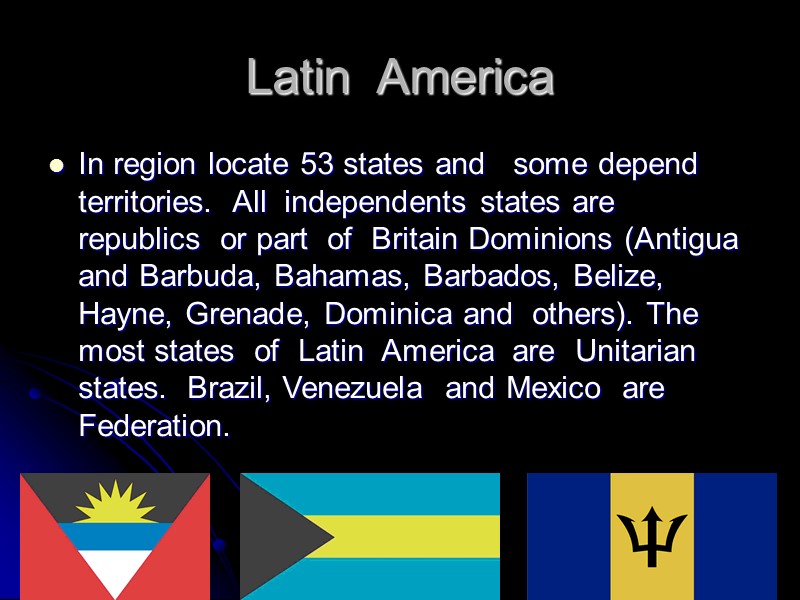
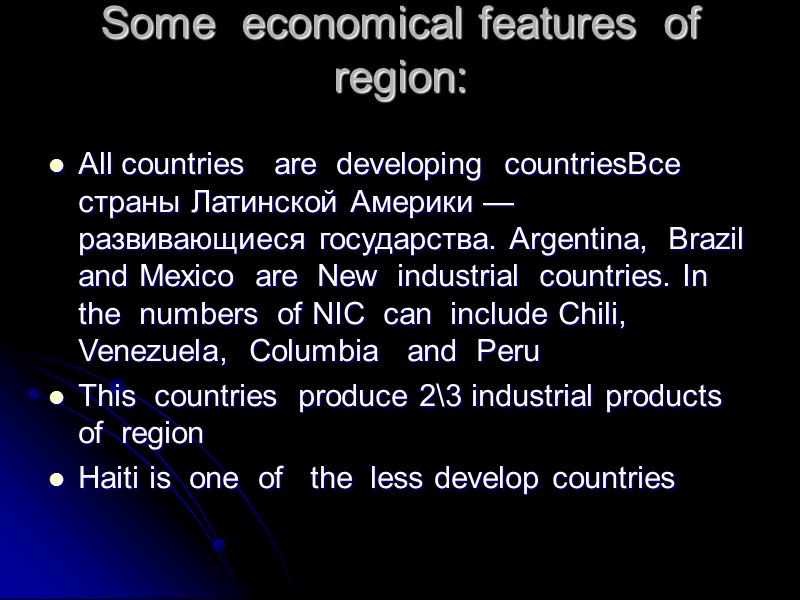
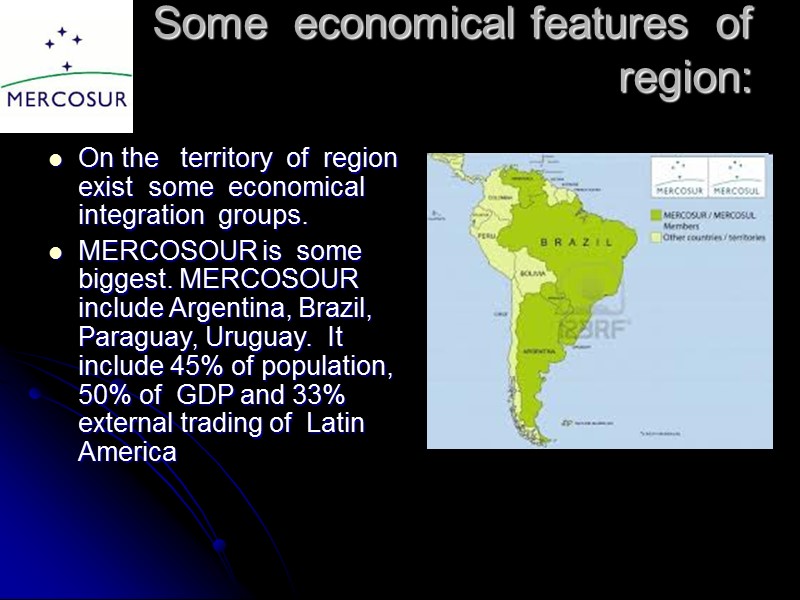
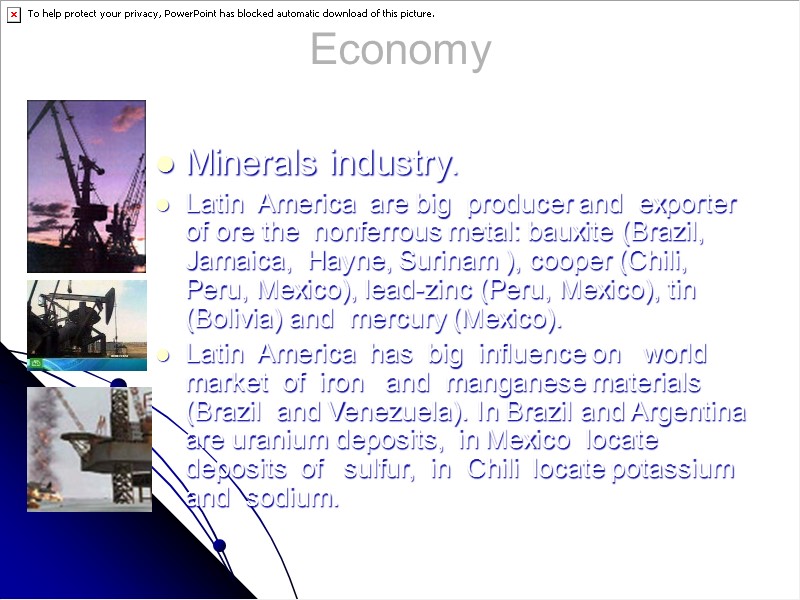
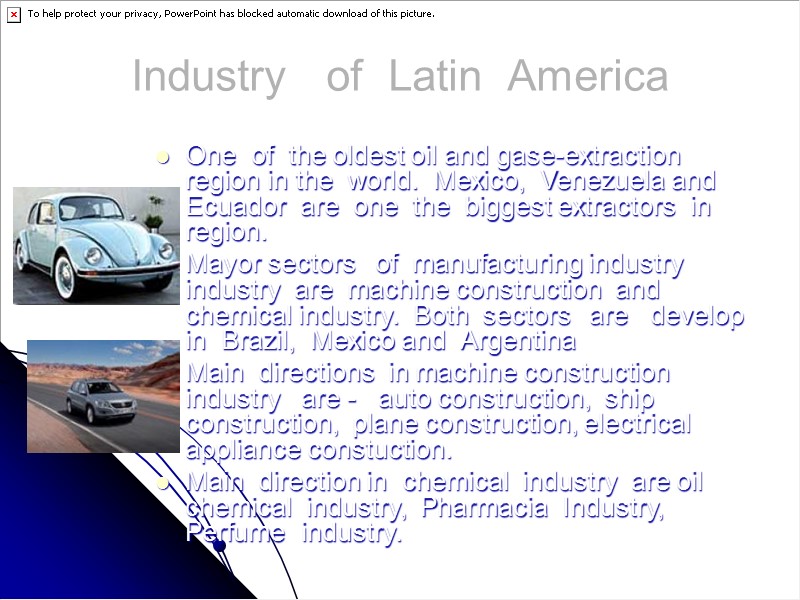
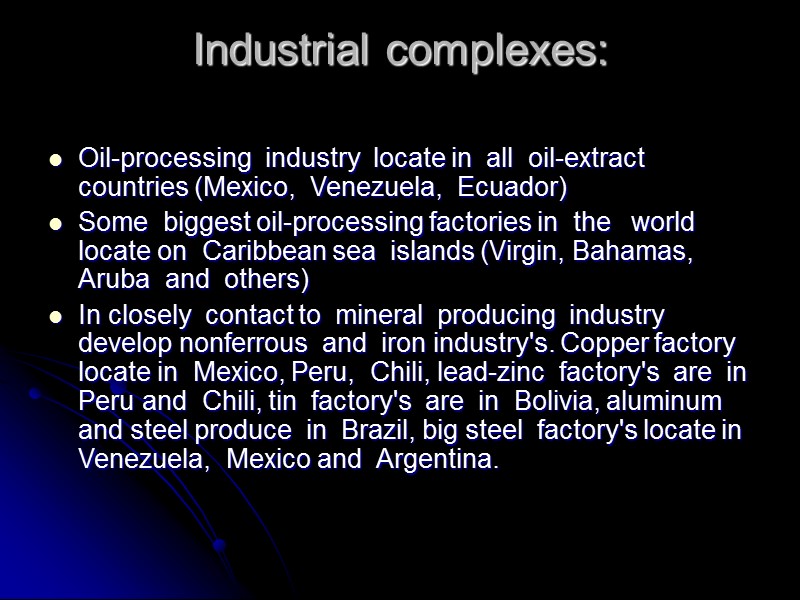
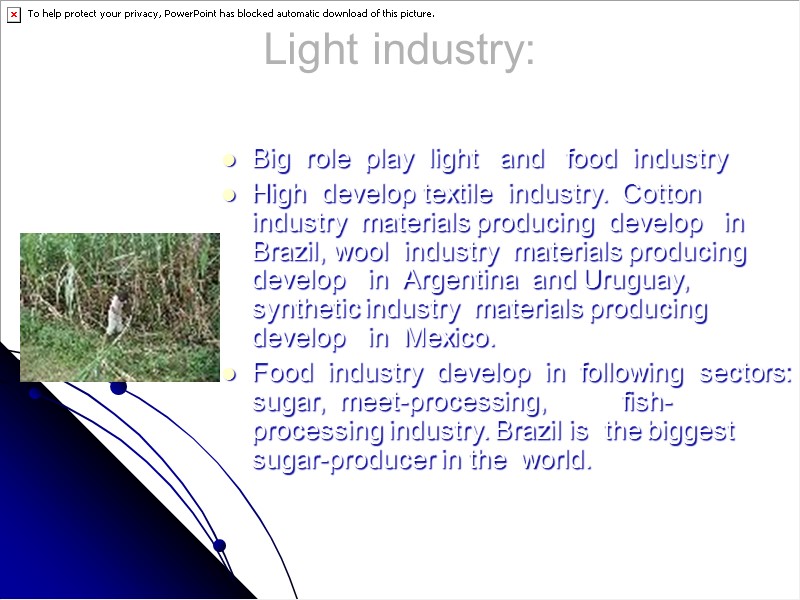
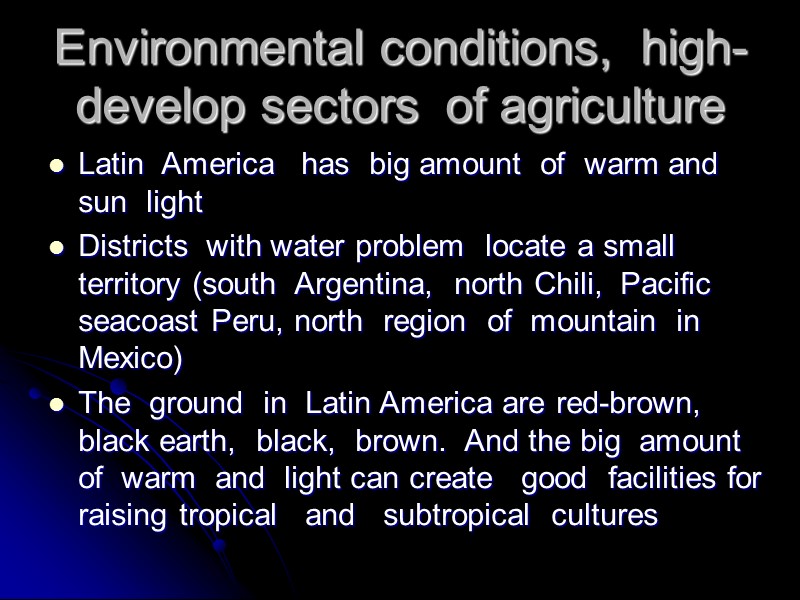
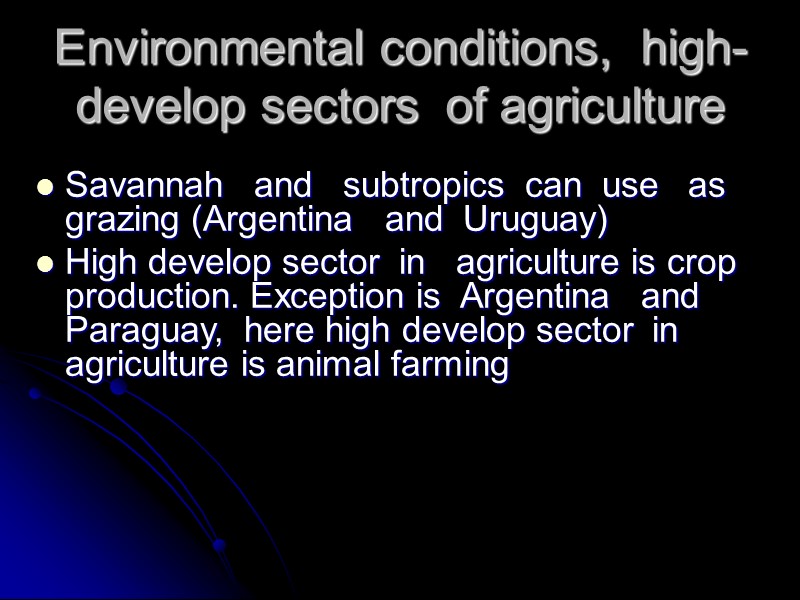
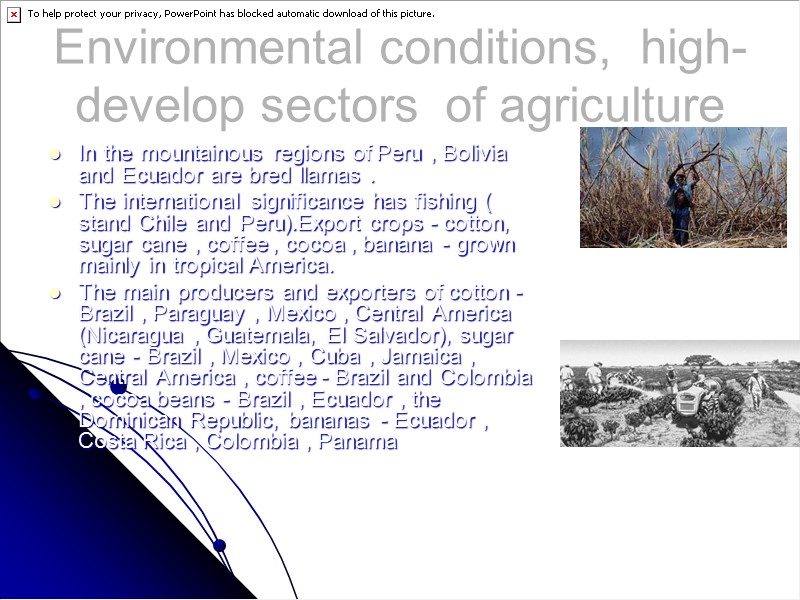
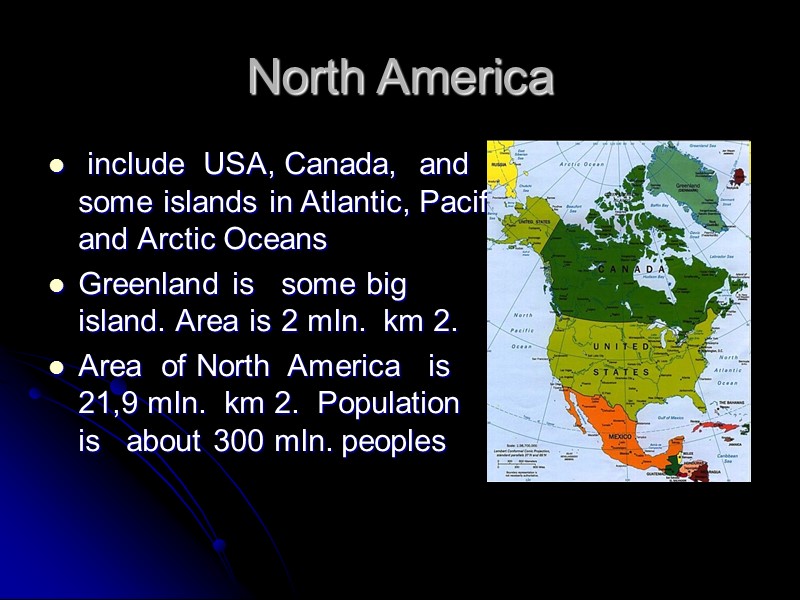
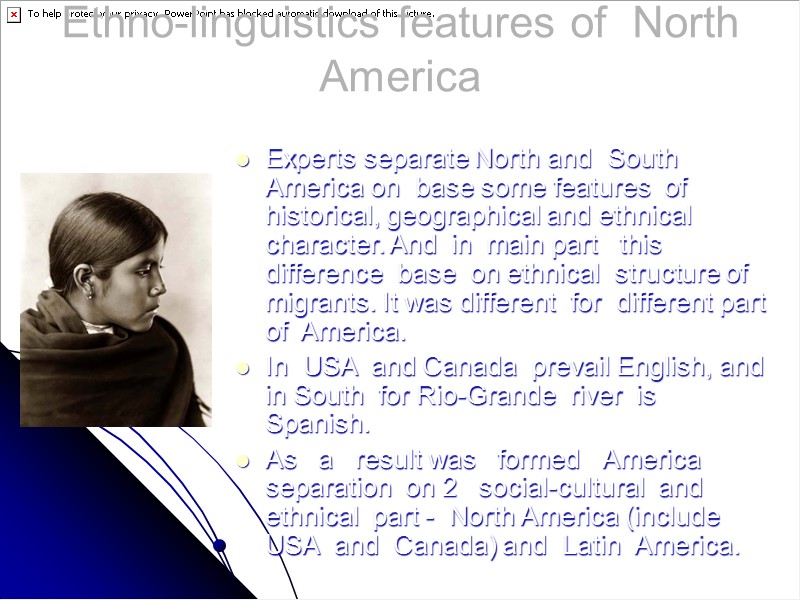
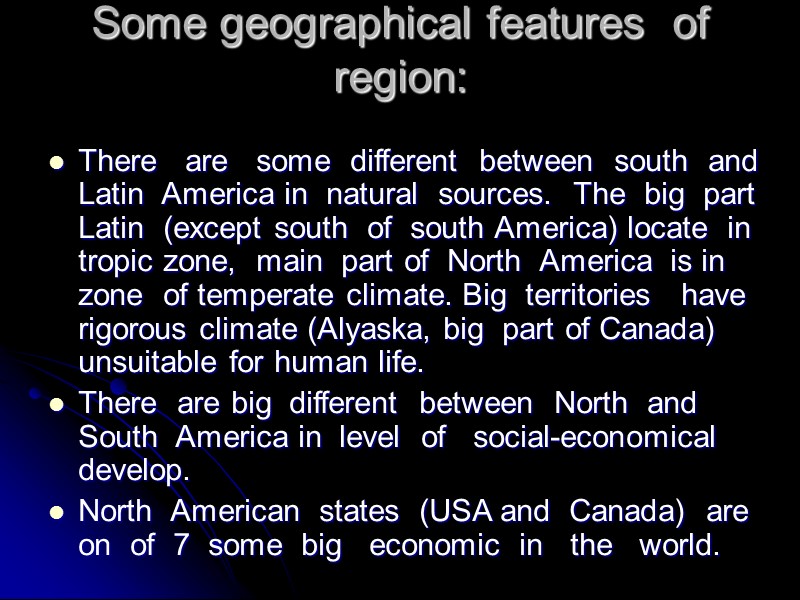
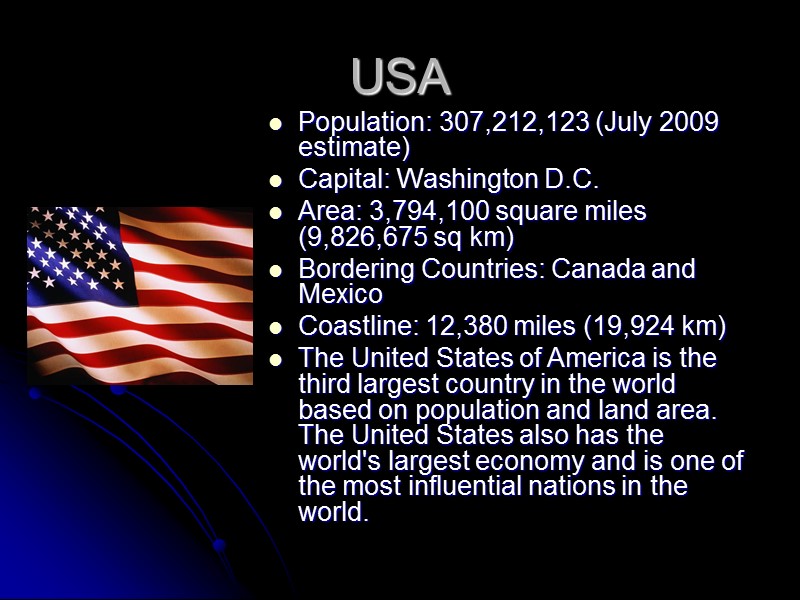
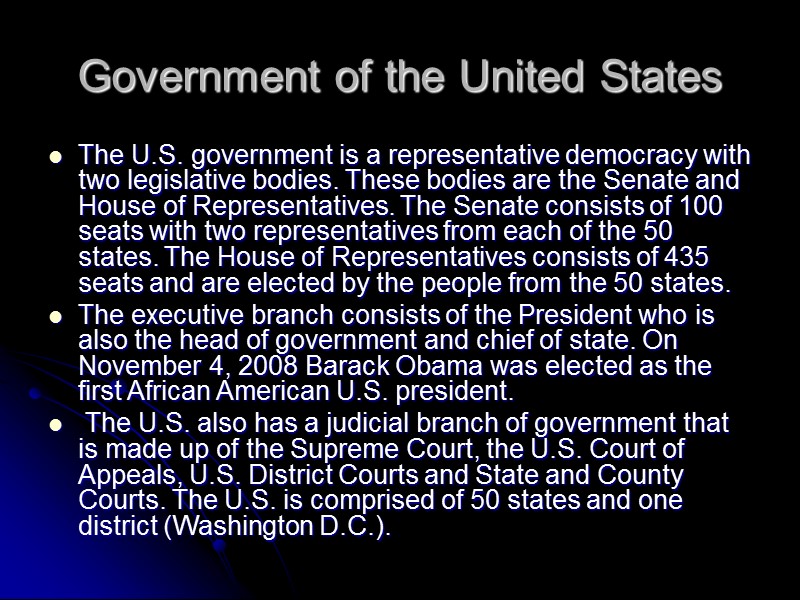
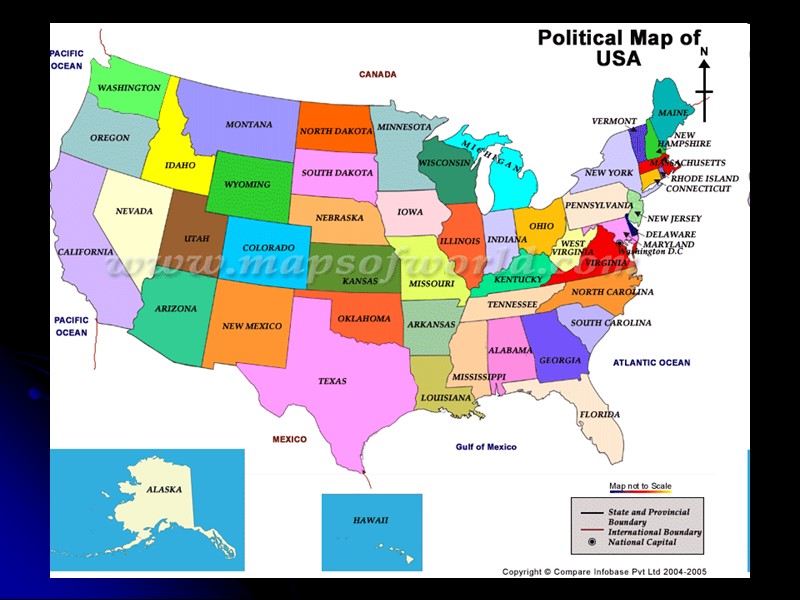
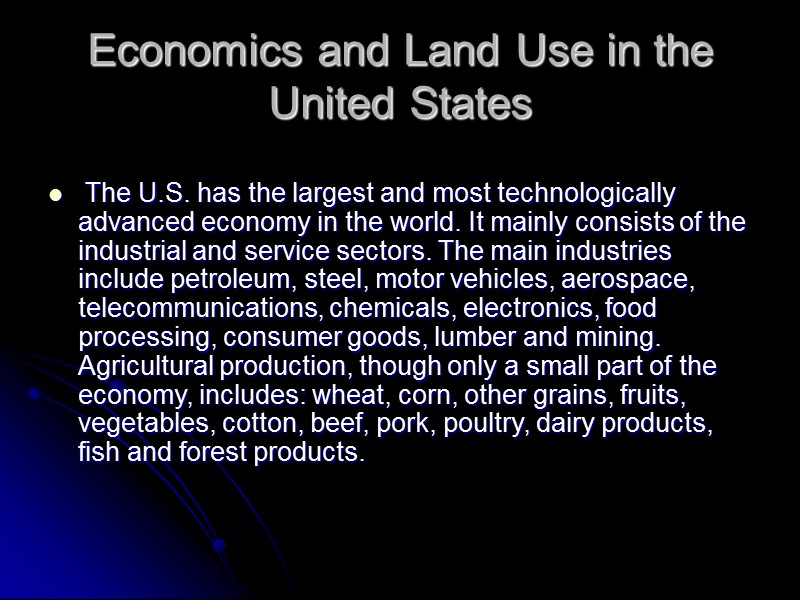
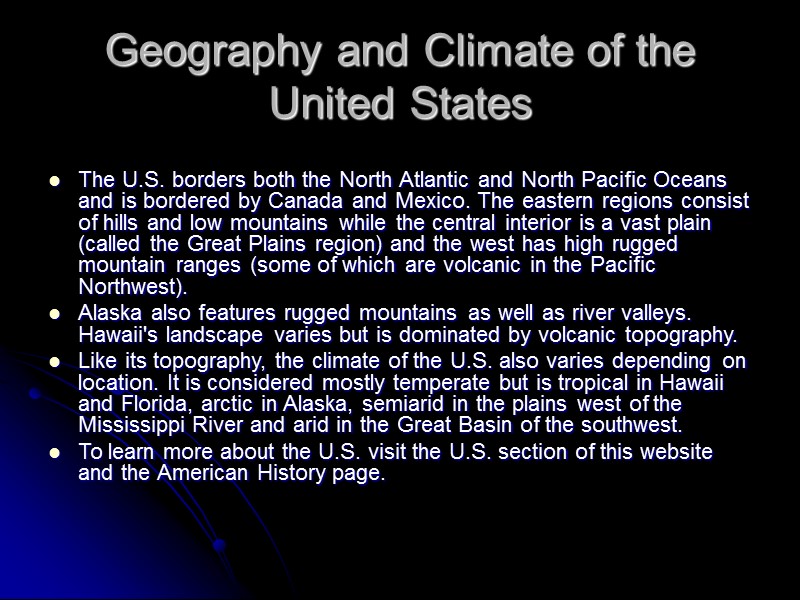
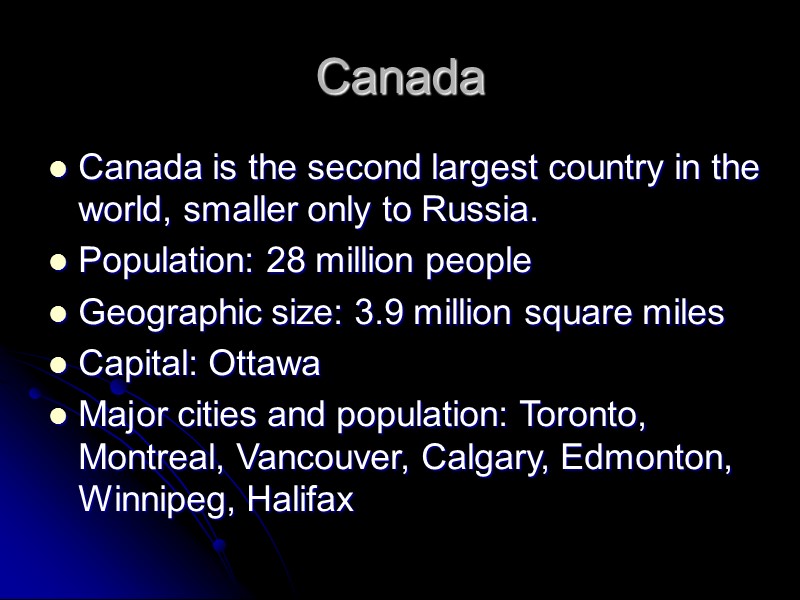
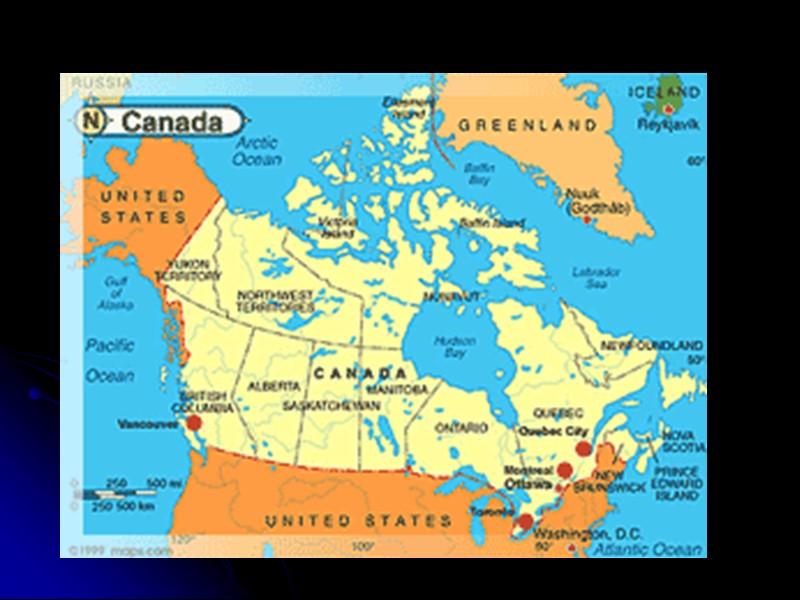
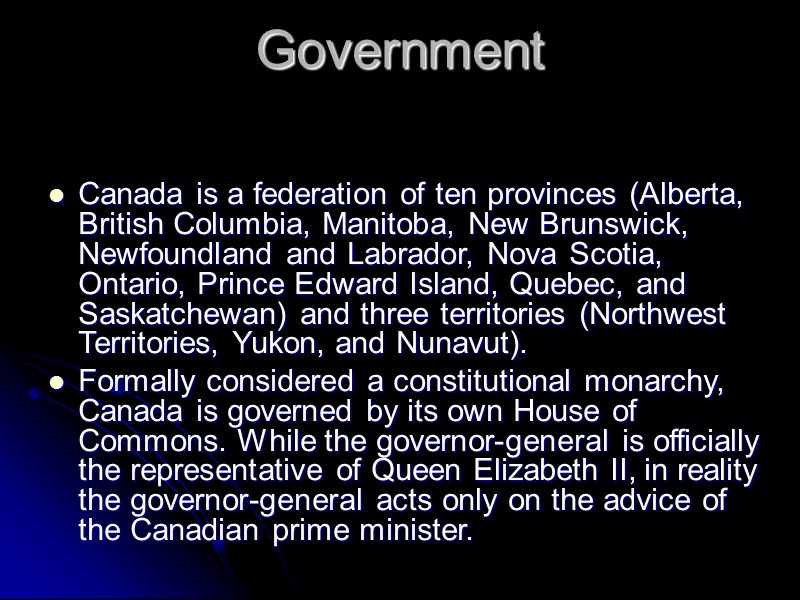
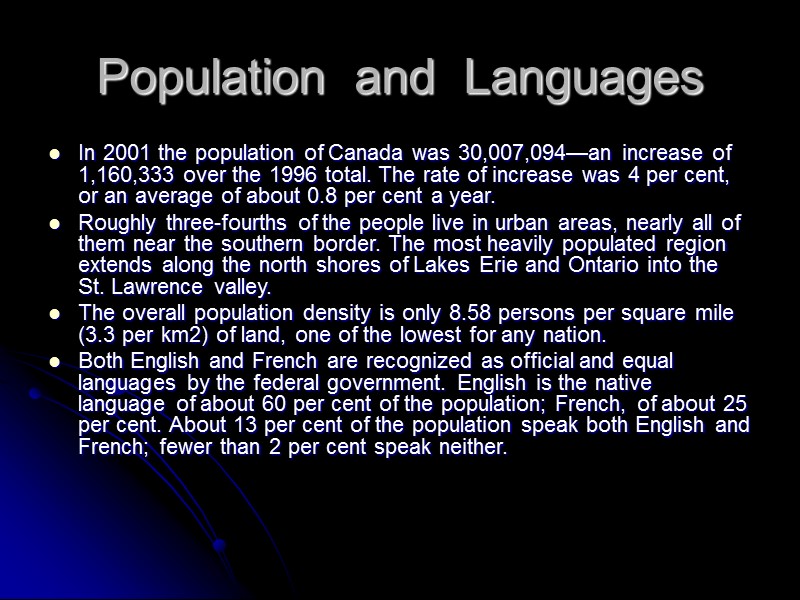
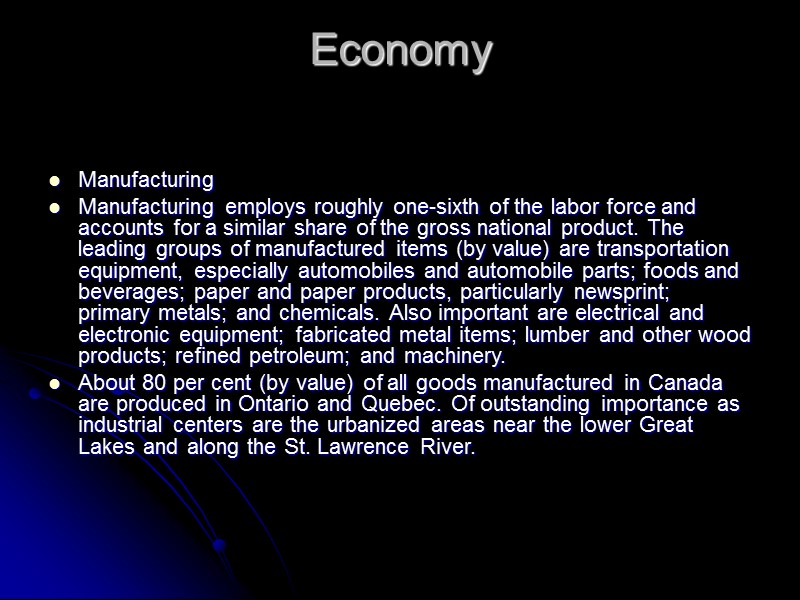
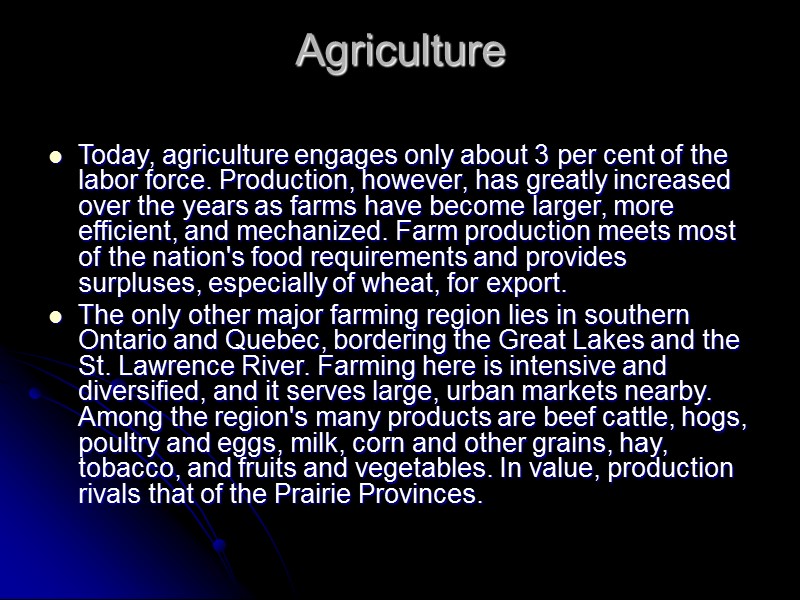

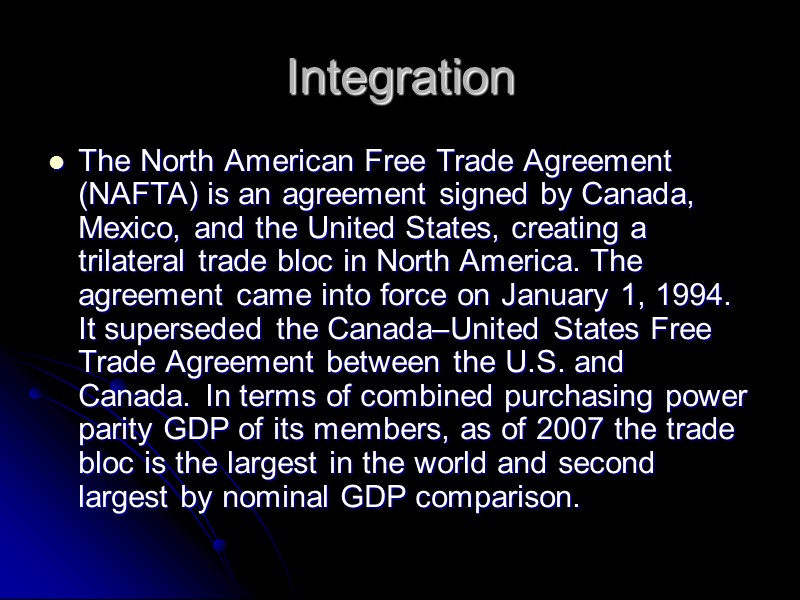
31798-america.ppt
- Количество слайдов: 33
 Introduction to Regional Studies America
Introduction to Regional Studies America
 Latin America Latin America refers to territories in America where the Spanish or Portuguese languages prevail: Mexico, most of Central and South America, and in the Caribbean; Cuba, the Dominican Republic, and Puerto Rico – in summary, Hispanic America and Brazil.
Latin America Latin America refers to territories in America where the Spanish or Portuguese languages prevail: Mexico, most of Central and South America, and in the Caribbean; Cuba, the Dominican Republic, and Puerto Rico – in summary, Hispanic America and Brazil.
 Latin America All countries of Latin America are former colonies of Europeans countries (in general Spain and Portugal) Are is 21 mln. km 2, population — about 500 mln. peoples Latin America outstrip Asia and Africa in level of industrialization. The first role in economy of region is processing industry
Latin America All countries of Latin America are former colonies of Europeans countries (in general Spain and Portugal) Are is 21 mln. km 2, population — about 500 mln. peoples Latin America outstrip Asia and Africa in level of industrialization. The first role in economy of region is processing industry
 Some geographical features of region: All countries of Latin America (excepting Bolivia and Paraguay) have a exit to sea (Atlantic or Pacific ocean) or are island state.. One of important feature of region is neighborhood with USA.
Some geographical features of region: All countries of Latin America (excepting Bolivia and Paraguay) have a exit to sea (Atlantic or Pacific ocean) or are island state.. One of important feature of region is neighborhood with USA.
 Ethnical situation in Latin America is very difficult. About 50% of population are metis. They are children of metis marriages. In Caribbean zone most population are niggers In Andes countries prevail Indians In Brazil is big part of population is “white” Some geographical features of region:
Ethnical situation in Latin America is very difficult. About 50% of population are metis. They are children of metis marriages. In Caribbean zone most population are niggers In Andes countries prevail Indians In Brazil is big part of population is “white” Some geographical features of region:
 The density of population is very low. Density of population is 24 peoples on km 2. Some high density of population is in Caribbean sea, Atlantic sea cost of Brazil, some part of capitals region 72% of populations living in cities The big territory of region is fast unpopulated Some geographical features of region:
The density of population is very low. Density of population is 24 peoples on km 2. Some high density of population is in Caribbean sea, Atlantic sea cost of Brazil, some part of capitals region 72% of populations living in cities The big territory of region is fast unpopulated Some geographical features of region:
 Latin America has a some big level of water support. The some biggest rivers of the world are Amazon, Orinoco, Parana. And they locate in Latin America. About 50% of territory Latin America is forests. It is one of the big riches the region Some geographical features of region:
Latin America has a some big level of water support. The some biggest rivers of the world are Amazon, Orinoco, Parana. And they locate in Latin America. About 50% of territory Latin America is forests. It is one of the big riches the region Some geographical features of region:
 Latin America In region locate 53 states and some depend territories. All independents states are republics or part of Britain Dominions (Antigua and Barbuda, Bahamas, Barbados, Belize, Hayne, Grenade, Dominica and others). The most states of Latin America are Unitarian states. Brazil, Venezuela and Mexico are Federation.
Latin America In region locate 53 states and some depend territories. All independents states are republics or part of Britain Dominions (Antigua and Barbuda, Bahamas, Barbados, Belize, Hayne, Grenade, Dominica and others). The most states of Latin America are Unitarian states. Brazil, Venezuela and Mexico are Federation.
 All countries are developing countriesВсе страны Латинской Америки — развивающиеся государства. Argentina, Brazil and Mexico are New industrial countries. In the numbers of NIC can include Chili, Venezuela, Columbia and Peru This countries produce 2\3 industrial products of region Haiti is one of the less develop countries Some economical features of region:
All countries are developing countriesВсе страны Латинской Америки — развивающиеся государства. Argentina, Brazil and Mexico are New industrial countries. In the numbers of NIC can include Chili, Venezuela, Columbia and Peru This countries produce 2\3 industrial products of region Haiti is one of the less develop countries Some economical features of region:
 On the territory of region exist some economical integration groups. MERCOSOUR is some biggest. MERCOSOUR include Argentina, Brazil, Paraguay, Uruguay. It include 45% of population, 50% of GDP and 33% external trading of Latin America Some economical features of region:
On the territory of region exist some economical integration groups. MERCOSOUR is some biggest. MERCOSOUR include Argentina, Brazil, Paraguay, Uruguay. It include 45% of population, 50% of GDP and 33% external trading of Latin America Some economical features of region:
 Economy Minerals industry. Latin America are big producer and exporter of ore the nonferrous metal: bauxite (Brazil, Jamaica, Hayne, Surinam ), cooper (Chili, Peru, Mexico), lead-zinc (Peru, Mexico), tin (Bolivia) and mercury (Mexico). Latin America has big influence on world market of iron and manganese materials (Brazil and Venezuela). In Brazil and Argentina are uranium deposits, in Mexico locate deposits of sulfur, in Chili locate potassium and sodium.
Economy Minerals industry. Latin America are big producer and exporter of ore the nonferrous metal: bauxite (Brazil, Jamaica, Hayne, Surinam ), cooper (Chili, Peru, Mexico), lead-zinc (Peru, Mexico), tin (Bolivia) and mercury (Mexico). Latin America has big influence on world market of iron and manganese materials (Brazil and Venezuela). In Brazil and Argentina are uranium deposits, in Mexico locate deposits of sulfur, in Chili locate potassium and sodium.
 One of the oldest oil and gase-extraction region in the world. Mexico, Venezuela and Ecuador are one the biggest extractors in region. Mayor sectors of manufacturing industry industry are machine construction and chemical industry. Both sectors are develop in Brazil, Mexico and Argentina Main directions in machine construction industry are - auto construction, ship construction, plane construction, electrical appliance constuction. Main direction in chemical industry are oil chemical industry, Pharmacia Industry, Perfume industry. Industry of Latin America
One of the oldest oil and gase-extraction region in the world. Mexico, Venezuela and Ecuador are one the biggest extractors in region. Mayor sectors of manufacturing industry industry are machine construction and chemical industry. Both sectors are develop in Brazil, Mexico and Argentina Main directions in machine construction industry are - auto construction, ship construction, plane construction, electrical appliance constuction. Main direction in chemical industry are oil chemical industry, Pharmacia Industry, Perfume industry. Industry of Latin America
 Oil-processing industry locate in all oil-extract countries (Mexico, Venezuela, Ecuador) Some biggest oil-processing factories in the world locate on Caribbean sea islands (Virgin, Bahamas, Aruba and others) In closely contact to mineral producing industry develop nonferrous and iron industry's. Copper factory locate in Mexico, Peru, Chili, lead-zinc factory's are in Peru and Chili, tin factory's are in Bolivia, aluminum and steel produce in Brazil, big steel factory's locate in Venezuela, Mexico and Argentina. Industrial complexes:
Oil-processing industry locate in all oil-extract countries (Mexico, Venezuela, Ecuador) Some biggest oil-processing factories in the world locate on Caribbean sea islands (Virgin, Bahamas, Aruba and others) In closely contact to mineral producing industry develop nonferrous and iron industry's. Copper factory locate in Mexico, Peru, Chili, lead-zinc factory's are in Peru and Chili, tin factory's are in Bolivia, aluminum and steel produce in Brazil, big steel factory's locate in Venezuela, Mexico and Argentina. Industrial complexes:
 Big role play light and food industry High develop textile industry. Cotton industry materials producing develop in Brazil, wool industry materials producing develop in Argentina and Uruguay, synthetic industry materials producing develop in Mexico. Food industry develop in following sectors: sugar, meet-processing, fish-processing industry. Brazil is the biggest sugar-producer in the world. Light industry:
Big role play light and food industry High develop textile industry. Cotton industry materials producing develop in Brazil, wool industry materials producing develop in Argentina and Uruguay, synthetic industry materials producing develop in Mexico. Food industry develop in following sectors: sugar, meet-processing, fish-processing industry. Brazil is the biggest sugar-producer in the world. Light industry:
 Environmental conditions, high-develop sectors of agriculture Latin America has big amount of warm and sun light Districts with water problem locate a small territory (south Argentina, north Chili, Pacific seacoast Peru, north region of mountain in Mexico) The ground in Latin America are red-brown, black earth, black, brown. And the big amount of warm and light can create good facilities for raising tropical and subtropical cultures
Environmental conditions, high-develop sectors of agriculture Latin America has big amount of warm and sun light Districts with water problem locate a small territory (south Argentina, north Chili, Pacific seacoast Peru, north region of mountain in Mexico) The ground in Latin America are red-brown, black earth, black, brown. And the big amount of warm and light can create good facilities for raising tropical and subtropical cultures
 Savannah and subtropics can use as grazing (Argentina and Uruguay) High develop sector in agriculture is crop production. Exception is Argentina and Paraguay, here high develop sector in agriculture is animal farming Environmental conditions, high-develop sectors of agriculture
Savannah and subtropics can use as grazing (Argentina and Uruguay) High develop sector in agriculture is crop production. Exception is Argentina and Paraguay, here high develop sector in agriculture is animal farming Environmental conditions, high-develop sectors of agriculture
 In the mountainous regions of Peru , Bolivia and Ecuador are bred llamas . The international significance has fishing ( stand Chile and Peru).Export crops - cotton, sugar cane , coffee , cocoa , banana - grown mainly in tropical America. The main producers and exporters of cotton - Brazil , Paraguay , Mexico , Central America (Nicaragua , Guatemala, El Salvador), sugar cane - Brazil , Mexico , Cuba , Jamaica , Central America , coffee - Brazil and Colombia , cocoa beans - Brazil , Ecuador , the Dominican Republic, bananas - Ecuador , Costa Rica , Colombia , Panama Environmental conditions, high-develop sectors of agriculture
In the mountainous regions of Peru , Bolivia and Ecuador are bred llamas . The international significance has fishing ( stand Chile and Peru).Export crops - cotton, sugar cane , coffee , cocoa , banana - grown mainly in tropical America. The main producers and exporters of cotton - Brazil , Paraguay , Mexico , Central America (Nicaragua , Guatemala, El Salvador), sugar cane - Brazil , Mexico , Cuba , Jamaica , Central America , coffee - Brazil and Colombia , cocoa beans - Brazil , Ecuador , the Dominican Republic, bananas - Ecuador , Costa Rica , Colombia , Panama Environmental conditions, high-develop sectors of agriculture
 North America include USA, Canada, and some islands in Atlantic, Pacific and Arctic Oceans Greenland is some big island. Area is 2 mln. km 2. Area of North America is 21,9 mln. km 2. Population is about 300 mln. peoples
North America include USA, Canada, and some islands in Atlantic, Pacific and Arctic Oceans Greenland is some big island. Area is 2 mln. km 2. Area of North America is 21,9 mln. km 2. Population is about 300 mln. peoples
 Ethno-linguistics features of North America Experts separate North and South America on base some features of historical, geographical and ethnical character. And in main part this difference base on ethnical structure of migrants. It was different for different part of America. In USA and Canada prevail English, and in South for Rio-Grande river is Spanish. As a result was formed America separation on 2 social-cultural and ethnical part - North America (include USA and Canada) and Latin America.
Ethno-linguistics features of North America Experts separate North and South America on base some features of historical, geographical and ethnical character. And in main part this difference base on ethnical structure of migrants. It was different for different part of America. In USA and Canada prevail English, and in South for Rio-Grande river is Spanish. As a result was formed America separation on 2 social-cultural and ethnical part - North America (include USA and Canada) and Latin America.
 There are some different between south and Latin America in natural sources. The big part Latin (except south of south America) locate in tropic zone, main part of North America is in zone of temperate climate. Big territories have rigorous climate (Alyaska, big part of Canada) unsuitable for human life. There are big different between North and South America in level of social-economical develop. North American states (USA and Canada) are on of 7 some big economic in the world. Some geographical features of region:
There are some different between south and Latin America in natural sources. The big part Latin (except south of south America) locate in tropic zone, main part of North America is in zone of temperate climate. Big territories have rigorous climate (Alyaska, big part of Canada) unsuitable for human life. There are big different between North and South America in level of social-economical develop. North American states (USA and Canada) are on of 7 some big economic in the world. Some geographical features of region:
 Population: 307,212,123 (July 2009 estimate) Capital: Washington D.C. Area: 3,794,100 square miles (9,826,675 sq km) Bordering Countries: Canada and Mexico Coastline: 12,380 miles (19,924 km) The United States of America is the third largest country in the world based on population and land area. The United States also has the world's largest economy and is one of the most influential nations in the world. USA
Population: 307,212,123 (July 2009 estimate) Capital: Washington D.C. Area: 3,794,100 square miles (9,826,675 sq km) Bordering Countries: Canada and Mexico Coastline: 12,380 miles (19,924 km) The United States of America is the third largest country in the world based on population and land area. The United States also has the world's largest economy and is one of the most influential nations in the world. USA
 Government of the United States The U.S. government is a representative democracy with two legislative bodies. These bodies are the Senate and House of Representatives. The Senate consists of 100 seats with two representatives from each of the 50 states. The House of Representatives consists of 435 seats and are elected by the people from the 50 states. The executive branch consists of the President who is also the head of government and chief of state. On November 4, 2008 Barack Obama was elected as the first African American U.S. president. The U.S. also has a judicial branch of government that is made up of the Supreme Court, the U.S. Court of Appeals, U.S. District Courts and State and County Courts. The U.S. is comprised of 50 states and one district (Washington D.C.).
Government of the United States The U.S. government is a representative democracy with two legislative bodies. These bodies are the Senate and House of Representatives. The Senate consists of 100 seats with two representatives from each of the 50 states. The House of Representatives consists of 435 seats and are elected by the people from the 50 states. The executive branch consists of the President who is also the head of government and chief of state. On November 4, 2008 Barack Obama was elected as the first African American U.S. president. The U.S. also has a judicial branch of government that is made up of the Supreme Court, the U.S. Court of Appeals, U.S. District Courts and State and County Courts. The U.S. is comprised of 50 states and one district (Washington D.C.).

 Economics and Land Use in the United States The U.S. has the largest and most technologically advanced economy in the world. It mainly consists of the industrial and service sectors. The main industries include petroleum, steel, motor vehicles, aerospace, telecommunications, chemicals, electronics, food processing, consumer goods, lumber and mining. Agricultural production, though only a small part of the economy, includes: wheat, corn, other grains, fruits, vegetables, cotton, beef, pork, poultry, dairy products, fish and forest products.
Economics and Land Use in the United States The U.S. has the largest and most technologically advanced economy in the world. It mainly consists of the industrial and service sectors. The main industries include petroleum, steel, motor vehicles, aerospace, telecommunications, chemicals, electronics, food processing, consumer goods, lumber and mining. Agricultural production, though only a small part of the economy, includes: wheat, corn, other grains, fruits, vegetables, cotton, beef, pork, poultry, dairy products, fish and forest products.
 Geography and Climate of the United States The U.S. borders both the North Atlantic and North Pacific Oceans and is bordered by Canada and Mexico. The eastern regions consist of hills and low mountains while the central interior is a vast plain (called the Great Plains region) and the west has high rugged mountain ranges (some of which are volcanic in the Pacific Northwest). Alaska also features rugged mountains as well as river valleys. Hawaii's landscape varies but is dominated by volcanic topography. Like its topography, the climate of the U.S. also varies depending on location. It is considered mostly temperate but is tropical in Hawaii and Florida, arctic in Alaska, semiarid in the plains west of the Mississippi River and arid in the Great Basin of the southwest. To learn more about the U.S. visit the U.S. section of this website and the American History page.
Geography and Climate of the United States The U.S. borders both the North Atlantic and North Pacific Oceans and is bordered by Canada and Mexico. The eastern regions consist of hills and low mountains while the central interior is a vast plain (called the Great Plains region) and the west has high rugged mountain ranges (some of which are volcanic in the Pacific Northwest). Alaska also features rugged mountains as well as river valleys. Hawaii's landscape varies but is dominated by volcanic topography. Like its topography, the climate of the U.S. also varies depending on location. It is considered mostly temperate but is tropical in Hawaii and Florida, arctic in Alaska, semiarid in the plains west of the Mississippi River and arid in the Great Basin of the southwest. To learn more about the U.S. visit the U.S. section of this website and the American History page.
 Canada is the second largest country in the world, smaller only to Russia. Population: 28 million people Geographic size: 3.9 million square miles Capital: Ottawa Major cities and population: Toronto, Montreal, Vancouver, Calgary, Edmonton, Winnipeg, Halifax Canada
Canada is the second largest country in the world, smaller only to Russia. Population: 28 million people Geographic size: 3.9 million square miles Capital: Ottawa Major cities and population: Toronto, Montreal, Vancouver, Calgary, Edmonton, Winnipeg, Halifax Canada

 Government Canada is a federation of ten provinces (Alberta, British Columbia, Manitoba, New Brunswick, Newfoundland and Labrador, Nova Scotia, Ontario, Prince Edward Island, Quebec, and Saskatchewan) and three territories (Northwest Territories, Yukon, and Nunavut). Formally considered a constitutional monarchy, Canada is governed by its own House of Commons. While the governor-general is officially the representative of Queen Elizabeth II, in reality the governor-general acts only on the advice of the Canadian prime minister.
Government Canada is a federation of ten provinces (Alberta, British Columbia, Manitoba, New Brunswick, Newfoundland and Labrador, Nova Scotia, Ontario, Prince Edward Island, Quebec, and Saskatchewan) and three territories (Northwest Territories, Yukon, and Nunavut). Formally considered a constitutional monarchy, Canada is governed by its own House of Commons. While the governor-general is officially the representative of Queen Elizabeth II, in reality the governor-general acts only on the advice of the Canadian prime minister.
 Population and Languages In 2001 the population of Canada was 30,007,094—an increase of 1,160,333 over the 1996 total. The rate of increase was 4 per cent, or an average of about 0.8 per cent a year. Roughly three-fourths of the people live in urban areas, nearly all of them near the southern border. The most heavily populated region extends along the north shores of Lakes Erie and Ontario into the St. Lawrence valley. The overall population density is only 8.58 persons per square mile (3.3 per km2) of land, one of the lowest for any nation. Both English and French are recognized as official and equal languages by the federal government. English is the native language of about 60 per cent of the population; French, of about 25 per cent. About 13 per cent of the population speak both English and French; fewer than 2 per cent speak neither.
Population and Languages In 2001 the population of Canada was 30,007,094—an increase of 1,160,333 over the 1996 total. The rate of increase was 4 per cent, or an average of about 0.8 per cent a year. Roughly three-fourths of the people live in urban areas, nearly all of them near the southern border. The most heavily populated region extends along the north shores of Lakes Erie and Ontario into the St. Lawrence valley. The overall population density is only 8.58 persons per square mile (3.3 per km2) of land, one of the lowest for any nation. Both English and French are recognized as official and equal languages by the federal government. English is the native language of about 60 per cent of the population; French, of about 25 per cent. About 13 per cent of the population speak both English and French; fewer than 2 per cent speak neither.
 Economy Manufacturing Manufacturing employs roughly one-sixth of the labor force and accounts for a similar share of the gross national product. The leading groups of manufactured items (by value) are transportation equipment, especially automobiles and automobile parts; foods and beverages; paper and paper products, particularly newsprint; primary metals; and chemicals. Also important are electrical and electronic equipment; fabricated metal items; lumber and other wood products; refined petroleum; and machinery. About 80 per cent (by value) of all goods manufactured in Canada are produced in Ontario and Quebec. Of outstanding importance as industrial centers are the urbanized areas near the lower Great Lakes and along the St. Lawrence River.
Economy Manufacturing Manufacturing employs roughly one-sixth of the labor force and accounts for a similar share of the gross national product. The leading groups of manufactured items (by value) are transportation equipment, especially automobiles and automobile parts; foods and beverages; paper and paper products, particularly newsprint; primary metals; and chemicals. Also important are electrical and electronic equipment; fabricated metal items; lumber and other wood products; refined petroleum; and machinery. About 80 per cent (by value) of all goods manufactured in Canada are produced in Ontario and Quebec. Of outstanding importance as industrial centers are the urbanized areas near the lower Great Lakes and along the St. Lawrence River.
 Agriculture Today, agriculture engages only about 3 per cent of the labor force. Production, however, has greatly increased over the years as farms have become larger, more efficient, and mechanized. Farm production meets most of the nation's food requirements and provides surpluses, especially of wheat, for export. The only other major farming region lies in southern Ontario and Quebec, bordering the Great Lakes and the St. Lawrence River. Farming here is intensive and diversified, and it serves large, urban markets nearby. Among the region's many products are beef cattle, hogs, poultry and eggs, milk, corn and other grains, hay, tobacco, and fruits and vegetables. In value, production rivals that of the Prairie Provinces.
Agriculture Today, agriculture engages only about 3 per cent of the labor force. Production, however, has greatly increased over the years as farms have become larger, more efficient, and mechanized. Farm production meets most of the nation's food requirements and provides surpluses, especially of wheat, for export. The only other major farming region lies in southern Ontario and Quebec, bordering the Great Lakes and the St. Lawrence River. Farming here is intensive and diversified, and it serves large, urban markets nearby. Among the region's many products are beef cattle, hogs, poultry and eggs, milk, corn and other grains, hay, tobacco, and fruits and vegetables. In value, production rivals that of the Prairie Provinces.
 Mineral resourses Canada is a world leader in production of asbestos, nickel, zinc, silver, molybdenum, sulfur, gypsum, uranium, potash, copper, lead, cadmium, gold, platinum, and cobalt. Increasingly, minerals are being smelted and refined within Canada; some are still exported as ores. Fuels account for nearly 60 per cent of the value of all minerals produced. Petroleum and natural gas are by far the most important fuels produced. The Prairie Provinces, espedaily Alberta, produce most of the petroleum and natural gas. Metals account for nearly 30 per cent of the value of Canada's total mineral output. Copper, gold, nickel, iron, uranium, zinc, and lead are the chief ones. Most of the known deposits of metals lie in the Canadian Shield and in the western mountains. Canada is a leading producer of potash. Other minerals produced include sulfur, asbestos, salt, peat, and gypsum.
Mineral resourses Canada is a world leader in production of asbestos, nickel, zinc, silver, molybdenum, sulfur, gypsum, uranium, potash, copper, lead, cadmium, gold, platinum, and cobalt. Increasingly, minerals are being smelted and refined within Canada; some are still exported as ores. Fuels account for nearly 60 per cent of the value of all minerals produced. Petroleum and natural gas are by far the most important fuels produced. The Prairie Provinces, espedaily Alberta, produce most of the petroleum and natural gas. Metals account for nearly 30 per cent of the value of Canada's total mineral output. Copper, gold, nickel, iron, uranium, zinc, and lead are the chief ones. Most of the known deposits of metals lie in the Canadian Shield and in the western mountains. Canada is a leading producer of potash. Other minerals produced include sulfur, asbestos, salt, peat, and gypsum.
 Integration The North American Free Trade Agreement (NAFTA) is an agreement signed by Canada, Mexico, and the United States, creating a trilateral trade bloc in North America. The agreement came into force on January 1, 1994. It superseded the Canada–United States Free Trade Agreement between the U.S. and Canada. In terms of combined purchasing power parity GDP of its members, as of 2007 the trade bloc is the largest in the world and second largest by nominal GDP comparison.
Integration The North American Free Trade Agreement (NAFTA) is an agreement signed by Canada, Mexico, and the United States, creating a trilateral trade bloc in North America. The agreement came into force on January 1, 1994. It superseded the Canada–United States Free Trade Agreement between the U.S. and Canada. In terms of combined purchasing power parity GDP of its members, as of 2007 the trade bloc is the largest in the world and second largest by nominal GDP comparison.
